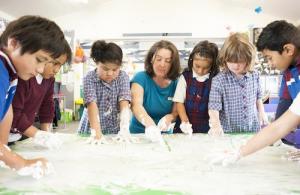Building alphabet knowledge (learning letter names, recognising both lower-case and upper-case formats, and matching letters with their sounds) is a strong focus in year 1 classrooms. With new learners, avoid focusing on letters that are visually similar (such as “b” and “d” or “n” and “u”) at the same time. Also, as noted in previous sections, the sounds of some letters can be easily confused across languages (see Learning through Talk, page 21).
For clarity, use the name of the letter rather than its sound when referring to single letters. There are letters that have more than one sound and some sounds that can be made by more than one letter. These are areas to explore after the students are reasonably confident with their alphabet knowledge. Vowels are an exception to this general rule. If you are focusing on a particular vowel sound, it is better to refer to the sound rather than the letter name so that the students are very clear about what sound to listen for.
An awareness of the many sounds of vowels develops over time as students engage in many reading and writing experiences. The long sounds for vowels will usually be the first ones learned because they “say their name”. Short vowels are trickier because their pronunciation alters according to the other letters around them and also because the differences between some of the short vowel sounds, such as “e” and “i”, are often subtle.
The following are suggestions for developing students’ alphabet knowledge.
- Have a name card for every student and use the cards for alphabet and word activities (for example, identifying their own name and those of others and identifying the first letter of their names).
- Give the students large paper cut-outs of the first letters of their names. Talk about how names always start with capital letters. Have them decorate their letter with pictures that show their hobbies, family members, pets, and so on. Ask each student to share his or her letter with a group or the class. Help the group to notice the visual features of the letters, such as curves, straight lines, and crossbars. Display the letters and refer to them often. (This is a great introductory activity for small groups of new entrants.)
- Read and discuss alphabet books often and have alphabet charts and/or picture cards on display.
- Establish an alphabet centre with a variety of items, such as alphabet books (including books made by the class), letter stamps and a stamp pad, magnetic letters and a magnetic board, materials so students can make their own alphabet books (paper, magazine pictures, paste, and writing implements), and alphabet games, including digital games.
- When focusing on a particular letter, you could do some or all of the following:
- brainstorm words starting with the letter
- display items starting with the focus letter on the alphabet table and add labels
- link the letter to a language experience activity, for example, focus on “j” when making “jelly”
- create alliterative phrases or sentences together and display them for the students to read
- use the focus letter to play I Spy
- reinforce the focus letter during transition times by relating it to the students’ names: If your name starts with (or ends with) “s” or has an “s” in it, line up at the door.
- create “letter factories”. Have a clear model of the focus letter for each student and ask them to create copies of the letter using such materials as play dough; sand, glue, and heavy paper; letter stamps; magnetic boards; large letter stencils; paint and brushes.
- Have a mirror available or have the students video each other so that they can see the shapes their mouths make when they articulate particular sounds.
- Encourage the students to find interesting ways of forming letters with their hands or bodies. For example, they could cross two fingers to make a “t” shape. They may need to find a partner to make some letters. Take photos and display them.
- Have the students practise “writing” letters with their fingers on each other’s backs.
- Provide activities that involve matching upper-case and lower-case forms of letters.



